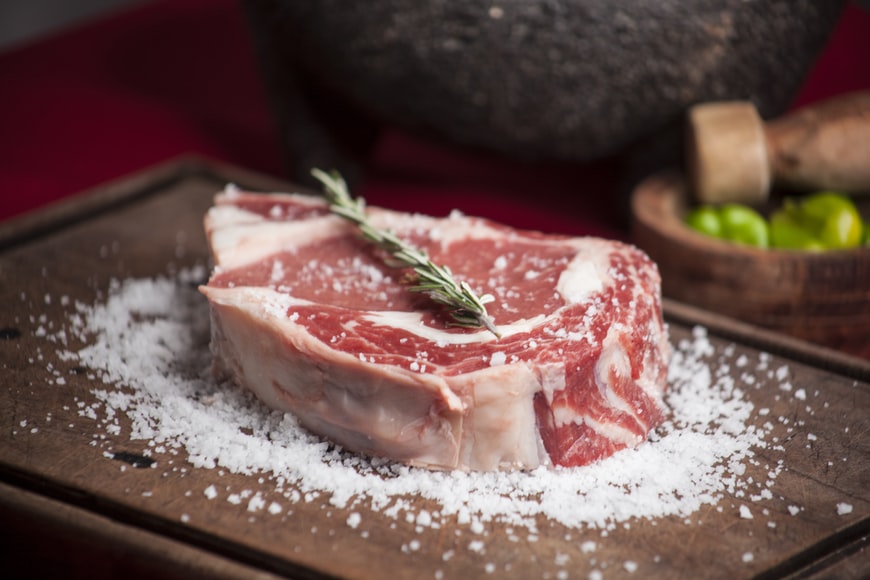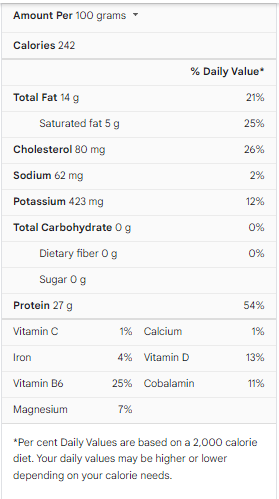It’s critical to determine whether pork is rotten before cooking to avoid food poisoning. Pork is one of those foods that should not be messed with. Pork that appears healthy will be pink in color, moist but not slimy, and odorless. To know how to tell if pork is bad, read further.
Ensure you’re storing your pork properly and inspecting it thoroughly before cooking it. This will mean the difference between a delectable dish that everyone loves and becoming unwell due to microorganisms. Before we go into all of that, let’s go through how to tell whether your pork is rotten in the first place.
 Pork Nutrition Fact
Pork Nutrition Fact
How to Tell if Pork is Bad?
1. The Smell of the Meat Tells it All
This is the simplest and most ancient method of distinguishing rotten meat from fresh meat. It’s worth noting that as bacteria infiltrate the meat, it tends to induce significant chemical and structural changes.
The more it attacks the pig, the worse the situation becomes. Even before you cook it, this can cause a substantial alteration in the pig’s color and fragrance. We’ll get into the color a little later, but the scent can range from ammonia-like to sulfur-like.
It’s vital to distinguish this odor from the one associated with vacuum-packed pork. Typically, vacuum-packed pork has an off-putting odor that quickly dissipates after rinsing the pork in cold water.
On the other hand, a bacteria-induced odor tends to stay regardless of whether the meat is washed or cooked.
2. Out for color shifts
Fresh pork is usually reddish in hue, with a few white strands. However, as the flesh spoils, the color changes from brownish to grey and occasionally greenish. This is a clear indication that you should avoid purchasing pork in the first place.
The presence of yeast is the primary cause of this color change. You may also need to be concerned about protein breakdown, Mold, and the appearance of freezer burns in addition to yeast.
According to experts worldwide, fresh meat should be reddish in hue. This color may fade or even darken over time if incorrect storage methods or lengthy storage are used, indicating that the breakdown process continues.
However, in rare circumstances, a change in hue does not always mean the entire pound of pork has gone wrong. All you have to do is trim the meat’s upper surface to see what the below surface looks like. If the color change is superficial, the meat is probably safe to eat.
Remember that the best fat is white, not yellowish or grey, when it comes to fat. To be on the safe side, avoid eating pork whose sight or odor raises your suspicions, and it’s better to be safe than sorry.
3. How does the pork feel?
Here’s another time-honored method used by chefs worldwide to detect whether or not the pork has gone rotten. It makes use of your touch senses.
When you hold fresh meat in your palm, it should feel solid. You should examine it closely and check for any symptoms of irregularity in the pad of your hand. Keep an eye out for any indicators of excessive dampness as well. Similarly, you should avoid going to extremes because even a piece of pork that is too dry or sticky might rot.
So, if your grocery shop allows it, squeeze the meat to ensure that it is of the high quality you expect. Don’t go with anything less than what’s been suggested here.
4. Package Inspection
You don’t have to rely on manual methods to determine the quality of pork all of the time, and this is especially crucial for those who are too busy to walk around tasting and handling meat. Pre-packaged pork is the most convenient way to go about this.
Manufacturers of pork wraps are usually required to include a “best by” or “use by” date. So keep an eye out for any pork that hasn’t been marked with this vital mark.
Also, if the label is on it, be sure the meat hasn’t gone past its suggested sell-by date. Never – and we mean never – try to cook or eat pork that has gone bad, as this can be dangerous to your health.
5. Trust Or Gut
Pork can rot early due to concerns such as improper meat processing or the killing of non-appropriate animals. Of course, this may not occur in the United States, but if you travel to other parts of the world, you’ll be astonished to learn that it does.
This is where your instincts come in handy. If you stroll into a meat counter and your gut tells you to stay away, do so.
Similarly, if you notice anything strange when the meat is being packaged for you, refuse the meat and leave. Some stores may even use shady tactics to change the sell-by date.
Nature, on the other hand, will never deceive you. So, follow your instincts if something doesn’t seem or sound right. It’s past time for you to demand a better bargain.
6. Signs of sloppy storage
Before you buy pork, the manner it’s stored can tell you a lot about whether it’s excellent or terrible. So, if you walk into a grocery shop and are greeted with a swarm of houseflies and a foul odor, something may be seriously wrong.
Similarly, if you come into the shop and notice that the meat is being held in less-than-ideal circumstances, it’s time to flee.
Essentially, you want to choose fresh meat that has been appropriately preserved. According to chefs worldwide, meat should not be kept in the refrigerator for more than four days.
This is because, after those days, the meat’s freshness begins to deteriorate, and safety may become an issue. As a result, even if the meat tastes good, it should be rejected.
That’s because, while the meat may still taste good in some situations, it could be harboring a fast-growing colony of germs that could infect your stomach and make matters worse.
7. It is Mold
Mold is a telltale sign that your pork is past its prime. As you may be aware, Mold grows in wet environments, so if you live in one, you should avoid storing your pork for an extended time before cooking it.
Some chefs even recommend boiling or salting the meat to prevent this from happening.
When you find Mold on your meat, you should discard it altogether.
Do not attempt to remove the Mold with your hands to cook the non-moldy areas.
On the other hand, Mold tends to run deep within, and you’d need more than a naked sight to judge the extent of its effects. As a result, the best advice is to avoid all such meat at all costs.
Don’t even try to boil it or remove the damaged area with a knife. Otherwise, you risk contracting a food illness and regretting it.
Pork Spoilage Can Be Prevented if You Follow These Steps
 Maintain a cool temperature
Maintain a cool temperature
According to the USDA, meat should be kept refrigerated at temperatures below 40°F. As soon as you come home from the grocery, put the pork in the fridge — or freezer.
Examine the packaging
When purchasing pork, avoid broken cartons, unclean wrappers, torn packing, and broken seals,” Amid or advises.
Freeze anything you won’t use right away
According to Beauchamp, rewrap and freeze the pork you bought if you won’t eat it within two or three days. “Freezing food slows the growth of microorganisms, extending the shelf life of the product. Plan to use an item within three days of defrosting it.
Thawing should be done with caution
Meat should be thawed in the refrigerator, cold water, or microwave, rather than on the counter or in hot water. You can cook pork without thawing it in the oven, on the stove, or the grill; however, it must be thawed first if you’re using a slow cooker.
Is Pork Edible After Seven Days?
Pork has a shelf life of 1-2 days after it has passed its “sell by” date, but it can be frozen to keep it fresh for longer, as shown in the chart and explanations below. Pig’s shelf life is determined by some factors, including the sell-by date, the preparation method, and how the pork was stored.
If your hog meat has a sell-by date printed on the package, it should last another day or two after that date. If there isn’t a date on the package, estimate that entire pieces of pork will last up to 5 days, ground pork will last 1 to 2 days, and cooked and leftover pork will last 3 to 4 days.
 What Happens if You Eat Pork That Has Gone Bad?
What Happens if You Eat Pork That Has Gone Bad?
“If you eat something past its expiration date and it’s ruined, you could get food poisoning,” said Summer Yule, MS, a registered dietitian nutritionist. Fever, chills, stomach cramps, diarrhea, nausea, and vomiting are signs of foodborne sickness.
Within 3 to 5 days of purchase, use or freeze beef, veal, hog, and lamb items with a “Sell-By” date. Cook or freeze fresh chicken, turkey, ground meat, and ground poultry within 1 to 2 days of purchase.
Conclusion
If the meat is brown or greenish, it is likely not fresh. Meat that is not fresh should be tossed if it has any stains or smells. The odor and color of the meat should be solid and clean. If it has an unpleasant odor or a slimy film, it is not a good cut of pork. The meat is too moist and may contain pathogenic bacteria.
To determine if pork is rotten, you should first check the smell. Good pork should have a sweet odor. If the meat has a sour odor, it is probably not fresh. Bad pork isn’t edible. A sour odor is a sign that the meat has gone wrong. It is also too wet to be able to handle it.

 Pork Nutrition Fact
Pork Nutrition Fact

 Maintain a cool temperature
Maintain a cool temperature What Happens if You Eat Pork That Has Gone Bad?
What Happens if You Eat Pork That Has Gone Bad?